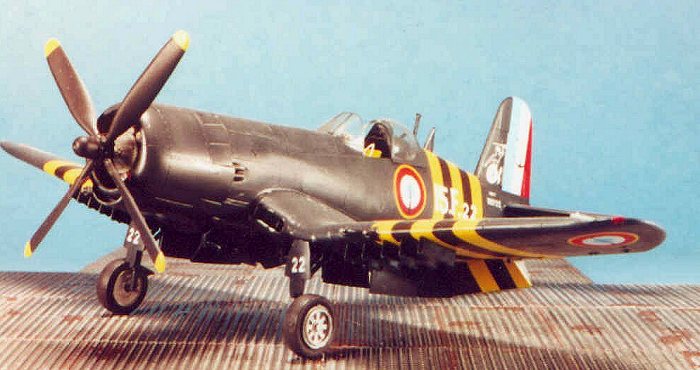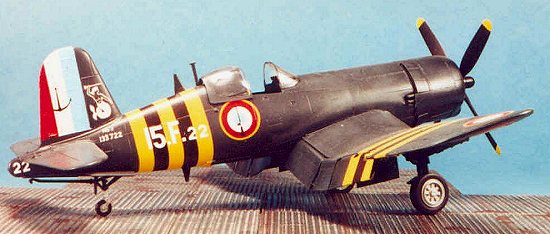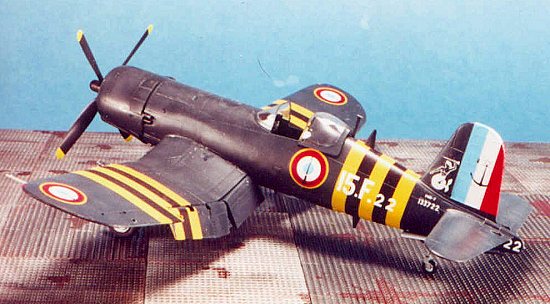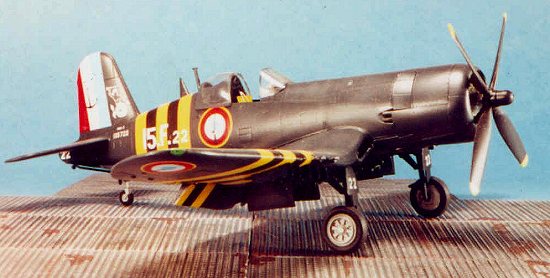
Hasegawa 1/48 F4U-7 Corsair
|
KIT # |
9077 (JT 77) |
|
PRICE: |
$27.98 |
|
DECALS: |
Two aircraft, one from 14F, one from 15F, at Suez, 1956. |
|
REVIEW: |
|
|
NOTES: |
|
THE LAST CORSAIR - BUILDING THE HASEGAWA 1/48 F4U-7

|
HISTORY |
The United States had the chance in 1945 to avoid 55 years of history, the deaths of over 55,000 Americans, several million Vietnamese, and the self-confidence of America as a country. All that had to be done was to tell the French they could not return to Indochina, and recognize the government of Ho Chi Minh - the only Asian independence movement that had fought on the Allied side during the war. The result would have been the situation that exists today, without all the bad blood both domestically and internationally. Unfortunately, the United States determined that the French - who had been defeated during the war in 1940 - might not be able to take the "shame" of being pushed out of their empire, with the result that Metropolitan France might go Communist. History has demonstrated that would not have happened, but such was the decision that was made. From 1945-50, the United States allowed France to attempt to retake their former colony, albeit without any major American aid.
The French returned to Indochina with a motley collection of cast-off aircraft acquired during the war. Douglas SBD-5 Dauntlesses, Bell P-63C Kingcobras, Spitfire IXs, Mosquitos and even Japanese Hyabusa fighters were pressed into service at the outset. By 1950, most of these aircraft had demonstrated their lack of capacity to fight the guerilla war, and both the French Navy and Air Force in Vietnam were equipped with cast-off US Navy F6F-5 Hellcats, most of which had over 2,000 hours at delivery. The SBD-5s had been replaced by two squadrons of Curtiss SB2C-5 Helldivers, which were the most modern aircraft.
Events in Asia changed in the fall of 1950, with the entry of Communist China into the Korean War, and the subsequent defeat and disorderly retreat of the American-led UN Army in North Korea. American leaders convinced themselves that this move by China signalled what might be the opening move of World War III. The anti-colonial struggle in Indochina was now seen as being part and parcel of the "international Communist conspiracy" which had begun the war in Korea.
For the French, the first benefit of this change in U.S. policy was the provision of former U.S. Navy Bearcats to the French Air Force. While the Bearcat had the excess power to maneuver effectively in restricted jungle valleys at low level, the airplane had not been designed for close air support, and the load it could carry was limited. The Aéronavale wanted something better, and the Military Assistance Program was willing to provide it for them.
The last F4U-5N came off the Dallas production line in October, 1951. It was followed by the F4U-6, which was redesignated the AU-1, since it was strictly a ground attack aircraft. Heavily armored, and equipped with ten underwing racks that could carry either 5" HVARs or 250-lb bombs each, the AU-1 had an R-2800-83W engine with only the crankcase blower as a two-speed, single-stage supercharger for low altitude work. 110 of these were in production when the Aéronavale let it be known that what they wanted for ground support in Indochina was a Corsair. Specifically, they wanted a Corsair with the ground attack capability of the AU-1 and the performance of the F4U-4.
 The result was the
F4U-7, which was the first brand-new straight-out-of-the-factory airplane to be
delivered to the French Navy since 1940. It was essentially an AU-1 airframe
with the high-altitude R-2800-18W engine of the F4U-4 (literally, since the
engine was no longer in production, those used for the F4U-7 were taken off
F4U-4s). The 96 that were built between June 1952 and Christmas Eve 1952 - when
the Corsair production line finally closed down - would serve the Aeronavale in
three different conflicts between 1952 and 1964.
The result was the
F4U-7, which was the first brand-new straight-out-of-the-factory airplane to be
delivered to the French Navy since 1940. It was essentially an AU-1 airframe
with the high-altitude R-2800-18W engine of the F4U-4 (literally, since the
engine was no longer in production, those used for the F4U-7 were taken off
F4U-4s). The 96 that were built between June 1952 and Christmas Eve 1952 - when
the Corsair production line finally closed down - would serve the Aeronavale in
three different conflicts between 1952 and 1964.
The French began taking delivery of their new Corsair at NAS Oceana in October 1952. It would initially equip 14 Flotille and 15 Flotille, achieving initial operational capability in early 1954.
The first French combat use of Corsairs was in the spring of 1954, in the doomed effort to save Dien Bien Phu. 14 Flotille, at the time stationed in Karouba, Tunisia, was moved sans aircraft to Da Nang, where the carrier U.S.S. "Saipan" delivered 25 Korean-veteran AU-1s direct from Marine Air Group 12 in Japan. The Corsairs flew valiantly, along with SB2C-5 Helldivers of 3rd Flotille, losing six aircraft and two pilots; Dien Bien Phu surrendered on May 7, 1954. It was effectively the end of the French phase of the Indochina War. Following the cease-fire on July 21, 1954, the AU-1s were returned to the U.S. (They would be refurbished and sold to the French for service in Algeria a few years later.)
14 Flotille's F4U-7s were ferried out to Da Nang aboard the light carrier "Bois de Belleau," and the unit flew them for the rest of the year during the French disengagement from Indochina, returning to Algeria in the spring of 1955. By this time, 12, 15, and 17 Flotilles were engaged in the Algerian War of Independence, flying from Oran, Telergma, Bizerte, and off the British-built carrier "Arromanches" during 1955-56. Losses were light during this period.
"Operation Musketeer":
The most visible use of the F4U-7 was in "Operation Musketeer," the Anglo-French operation to secure control of the Suez Canal from Egypt following its nationalization by Gamal Abdel Nasser in 1955. In concert with Israel, the operation began in October 1956, and has been known as the Sinai War to those who were not in on what was really going on. When the Israelis had defeated the Egyptian armed forces in the Sinai and were approaching the canal in late October, Britain and France - as previously planned - called on both parties to halt operations to save the Suez Canal. Predictably, Nasser refused; the British and French intervened on November 1, 1956, with a force that included three British and two French carriers, the "Arromanches" and "Lafayette" (formerly the U.S.S. "Langley"). Flotilles 14 and 15 flew their 36 F4U-7s from these ships. Following strikes on Egyptian air bases that neutralized the Egyptian jets on the first day of the operation, the Corsairs ranged along the Mediterranean coast for the remainder of Musketeer, seeking targets of opportunity. During this time they sank an Egyptian torpedo boat, and the Commanding Officer of 14F was killed by anti-aircraft fire over Cairo, while another F4U-7 was wrecked in an operational accident. Considering that the pilots were flying up to four sorties daily, the losses were exceptionally low.
The Suez Intervention was the Corsair's last major combat operation. The 36 Corsairs had constituted one quarter of the allied forces' carrier strike aircraft. The airplanes would continue in combat use for strikes against Algerian guerrillas until the end of the War of Independence in 1961, at which time they were withdrawn to the French base of Toulon. The F4U-7s were replaced in 1964 by the F8E(FN) Crusader.
BuNo 133722:
Among the 96 F4U-7s was BuNo 133722, officially the 86th of the 96, which came off the production line on December 14, 1952, ten days before the last Corsair produced. The airplane was accepted into the Aéronavale in February 1953 at NAS Oceana, initially serving with 15 Flotille as 15.F.22 for the next four years, which would include service aboard "Arromanches" during the Suez Intervention. Between 1956 and 1963, the airplane would serve with 14F and 17F, before she was taken off service in the summer of 1963; returned to service in 1964 during a flare-up with Morocco over the French base there, 133722 and her sisters were finally put off operations in the summer of 1964. For a few more years, 133722 would soldier on at Toulon as an instructional airframe, until in 1966 she would be pushed into the back of a warehouse, her wings removed and stacked atop each other beside the fuselage, left horizontal stabilizer sectioned with a hacksaw, with the engine and accessories removed.
Four other F4U-7s, 133693, 133710, 133714, and another one unidentified, were returned to the United States, where 133714 became known on the west coast warbird circuit as "The Blue Max," prior to crashing at Brown Field, San Diego, in the early 1980s; 133693 was bought by John Schaufhausen, of Spokane, Washington, and gained a certain fame as the lead ship of four Corsairs that flew in the 1970s TV show, "Baa Baa Blacksheep." 133710 ended up at the Battleship "Alabama" memorial, while the other is at the Marine Museum in Quantico. 133722 remained in her warehouse gathering dust, remembered only by the Chief Petty Officer in charge of the working party that put her there, until the Chief, by then retired, made the acquaintance of Gary Harris, a pilot for Pan Am, in 1972. It took Gary a 18 months of negotiations with the French Navy, and his promise to restore 133722 as an Aéronavale airplane, before she appeared at Half Moon Bay Airport in the spring of 1973, at which time I made my acquaintance with her.
The first thing was to find out what was there. The instrument panel was a mass of holes, but surprisingly enough most other parts other than the engine and accessories were there. The airplane had been pained four or five times in its career, more blue paint over what was already on; under the hot Mediterranean sun, the lacquer finish was baked on, becoming nearly impervious to the strongest industrial-strength paint strippers. When we finished the nine-month effort to clean the airframe, there was no corrosion anywhere; it was like it had been cocooned.
In the fall of 1973, being Restorer in Charge of Stripping Paint (a job that exactly matched my technical restoration skills), I made a momentous discovery, when I was scrubbing paint off the side of the Corsair: yellow and black stripes began to appear from under the coats of faded Glossy Sea Blue above. I called Gary over, we scraped off some more paint, and realized we could research the operational history of the airplane with paint remover! Eventually, over the next month, we uncovered all the invasion stripes and associated insignia, measured them and I photographed them with slides. Gary decided he would restore 133722 as she had appeared at Suez.
 133722 presented
some problems, particularly the fact there was no engine or cowling, and no
F4U-7 cowlings available anywhere in the world, at least than anyone knew of.
Eventually, the airplane was equipped with a quick engine change kit from an
F4U-4, and an F4U-4 cowling was obtained. There has been a lot of controversy
over whether the F4U-7 was really an AU-1 with an F4U-4 engine, or an F4U-4 with
metal wings. It was definitely the former! It took metal smith Ray Boone some
six months to reconfigure the F4U-4 cowling pieces to match the F4U-7 airframe
attachment points; there was no commonality. Bert Kinzey and every other
aviation expert who has claimed the F4U-7 is the same length as an F4U-4 are
WRONG!!! For once and for all:
133722 presented
some problems, particularly the fact there was no engine or cowling, and no
F4U-7 cowlings available anywhere in the world, at least than anyone knew of.
Eventually, the airplane was equipped with a quick engine change kit from an
F4U-4, and an F4U-4 cowling was obtained. There has been a lot of controversy
over whether the F4U-7 was really an AU-1 with an F4U-4 engine, or an F4U-4 with
metal wings. It was definitely the former! It took metal smith Ray Boone some
six months to reconfigure the F4U-4 cowling pieces to match the F4U-7 airframe
attachment points; there was no commonality. Bert Kinzey and every other
aviation expert who has claimed the F4U-7 is the same length as an F4U-4 are
WRONG!!! For once and for all:
The F4U-7 is an AU-1 with an F4U-4 engine!!!!!
133722 first flew in August 1976, in bare metal finish. With US insignia hastily pasted on, she appeared later that month at that year's Fresno Warbirds Fly-In, where Pappy Boyington endorsed the logbook to the effect that "this is the cleanest Corsair I have ever seen." In early 1977, she was repainted as she had appeared at Suez, becoming the only flying warbird restored in operational markings the specific airframe had carried at a historically-significant event. In August 1977, 133722 made quite a stir when she appeared at the Abbotsford, B.C. Air Show.
In 1982, Gary sold 133722 to Stephen Grey, and the airplane returned to Europe, where it became well-known on the airshow circuit and appeared on the cover of numerous aviation magazines over the years, with that distinctive paint scheme. Unfortunately, she was sold in 1996 to the Tillamook Air Museum in Evergreen, Washington, where 133722 - the last Corsair built still flying - was stripped and repainted as an anonymous Korean-era American Corsair. It may be that, as warbird owners are wont to say, "I like that (incorrect) scheme, and besides - I own it!" but to my mind, Tillamook Air Museum committed an atrocity against history when they did that, one for which I have yet to forgive them.
|
THE KIT |
There has been one attempt to produce a kit of the F4U-7 in 1/48 scale, a bad effort by Heller in the early 1990s. The best thing to be said about this kit was that it had an excellent decal sheet - in fact, if you have that model lying around in the pile, it would be a good idea to save those decals for this new kit. Until now, the only way I knew of to make a 1/48 F4U-7 was to get a conversion set from Missing Link Models to use on the Hasegawa F4U-4 kit. If one obtained the AU-1 cowling and mated it with the chin intake from the F4U-4 kit, something sort of approximating an F4U-7 could be created, and SuperScale had included a 14F airplane on one of their decal sheets in 1982.
The appearance of the Hasegawa F4U-7 effectively renders all other kits of the F4U-7 obsolete. As one of the series of late-model Corsairs beginning with the F4U-5, it fills a badly-needed gap in "Corsairology."
|
CONSTRUCTION |
Other than some differences associated specifically with the F4U-7, which I will go into here, the kit assembles as does the F4U-5, and I refer the reader to the full-build review of that kit here at Modeling Madness.
As with the F4U-5 and - I am sure - the coming AU-1, the big problem is the "ridge" in the forward fuselage created by the replacement mold to change the forward section of the fuselage from sub-type to sub-type. This ranges from almost not noticeable to really bad. In the case of my F4U-7, it was in the mid-range, and only needed to be sanded down and rescribed to disappear under a coat of paint.
I painted the cockpit black, and replaced the incorrect radar screen for the F4U-5N in the instrument panel with an instrument from the alternative instrument panel decal; this might not be entirely accurate, but it's close enough.
The oil coolers of the AU-1 and the F4U-7 were moved from the inner wing to the fuselage. While the difference in wing intakes between the F4U-5 and the later airplanes has been take care of with a new part, the modeler should be aware that they should putty over and sand smooth the area under the inner wing where the oil cooler vent is molded.
The AU-1 and F4U-7 had sheets of armor plate welded to the lower fuselage. As I recall from working on 133722, there were three large pieces of armor plate just ahead of, directly below, and just behind the cockpit area. I took some 10-thou plastic sheet, cut out panels that I think (going from memory) are approximately the right size, and glued them into position on the lower fuselage after I attached the wing and fuselage sub assemblies.
Do not attach the underwing weapons pylons until all decals have been applied.
I replaced the incorrect wheels with a better set from my spares box. One might consider getting the True Details resin wheel set for F4Us, as those in the kit are too small in diameter and too narrow.
|
PAINT & DECALS |
Painting:
 Ordinarily, I would
have proceeded to paint and mask and paint to get the yellow-and-black
"Suez stripes" first. However, Hasegawa includes stripes in the kit. I
cut a piece of stripe for the wing and tried it on another Glossy Sea Blue
Corsair, and found that it is opaque enough to use on this model. Because of
that, I proceeded to paint the model overall Glossy Sea Blue, using Gunze-Sanyo
"Midnight Blue." By 1956, there had been very little fading of the
original paint on the F4U-7s, so I "weathered" the paint with a dollop
of Gunze-Sanyo "Navy Blue" and blotched the upper surfaces of wing and
horizontal stabilizer, and upper area of the fuselage, to simulate sun fading. I
painted the lower end of the main gear, the lower end of the tailwheel, and the
hubs of the main wheels aluminum lacquer (using SnJ), as 133722 had been painted
when she first arrived back from France.
Ordinarily, I would
have proceeded to paint and mask and paint to get the yellow-and-black
"Suez stripes" first. However, Hasegawa includes stripes in the kit. I
cut a piece of stripe for the wing and tried it on another Glossy Sea Blue
Corsair, and found that it is opaque enough to use on this model. Because of
that, I proceeded to paint the model overall Glossy Sea Blue, using Gunze-Sanyo
"Midnight Blue." By 1956, there had been very little fading of the
original paint on the F4U-7s, so I "weathered" the paint with a dollop
of Gunze-Sanyo "Navy Blue" and blotched the upper surfaces of wing and
horizontal stabilizer, and upper area of the fuselage, to simulate sun fading. I
painted the lower end of the main gear, the lower end of the tailwheel, and the
hubs of the main wheels aluminum lacquer (using SnJ), as 133722 had been painted
when she first arrived back from France.
Decals:
I first applied the "Suez stripe" decals. These are sized perfectly, and went on with no difficulty. I had at first thought the yellow was more intense than was the case on the actual airplane, but once these decals were on over the GSB surface below, they assumed the right shade of yellow. The decals are thick, and it took repeated applications of Micro-Sol over several hours to get them to snug down, but in the end they looked as if they had been painted on. I strongly suggest that those of you who are "invasion stripe challenged" put these decals to use when you make this model.
I had decided to do 133722 as she had appeared at Suez. My friend Sebastien Privat sent me the Adeco decals he had not kept for his kit, and by cutting and trimming, I was able to come up with BuNo 133722, and the 15.F.22 on the fuselage, as well as the "22" on the extreme tail and the forward landing gear cover. I used the kit decals for the national insignia and the Flotille insignia for 15F that goes on the rudder.
Once everything had set, I washed the model thoroughly to remove decal solvent, and shot a coat of Future mixed 50-50 with my "Flat Future" to get a glossy surface that was more realistic than the overly-glossy surface that would result from applying Future alone.
Final Assembly:
I attached the underwing pylons. Be careful when doing this: they should be perpendicular to the ground, not to the wing, when installed correctly. I attached the wheels, the prop and the canopy in the open position, then made the radio aerial from nylon thread. I airbrushed the "greyed-out" exhaust area one sees on F4U-7s, and did a modicum of paint chipping, bearing in mind this was virtually still a new airplane that was getting loving care from the Aéronavale at the time.
|
CONCLUSIONS |
The first time I saw a picture of an F4U-7 in "Suez stripes" I wanted to do one that way. Now there is a good kit of this airplane, and my model represents the airplane restoration I was most closely associated with, which brings back good memories every time I look at it.
And I still don't forgive Tillamook Air Museum for their crime.
Copyright ModelingMadness.com. All rights reserved. No reproduction in part or in whole without express permission.
If you would like your product reviewed fairly and fairly quickly, pleasecontact the editor or see other details in the Note to Contributors.